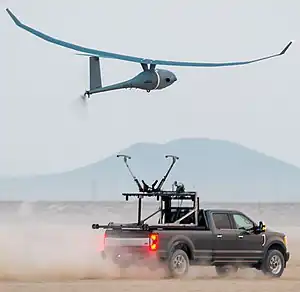Vanilla UAV
The Vanilla UAV is a long-endurance long-endurance, low-cost UAV produced by American manufacturer Vanilla Unmanned.
| Vanilla Unmanned UAV | |
|---|---|
 | |
| Vanilla Unmanned UAV takeoff | |
| Role | Unmanned aerial vehicle |
| National origin | United States |
| Manufacturer | Vanilla Unmanned |
| Status | In development |
Development
Having cost $3 million to develop, its production cost would be $500,000 while it is comparable to the 24h-endurance Boeing Insitu ScanEagle.[1] In October 2017, it completed a five-day 1 h 20 min flight at NASA Wallops in Virginia, covering 7,000 miles (11,265 km) and landing with three days of fuel remaining.[1] Vanilla seeks to raise $5 million as a larger design could carry a 250 lb (113 kg) payload.[1]
Founded by aerostructures designer Daniel Hatfield, systems engineer Neil Boertlein and programme manager Jeremy Novara, Vanilla Aircraft had an annual budget of $300,000 from NASA and the US Department of Defense.[1] In October 2020, Vanilla Unmanned was acquired by Platform Aerospace, a provider of aircraft prototyping, modification, and systems integration.[2]
On 2 October 2021, a Vanilla UAV completed an eight-day and 50 minute flight from Edwards AFB in California, flying 10,600 nmi (19,600 km) in circuits; an internal combustion engine-powered UAV record to be ratified by the FAI.[3][4] In November 2021, NASA flew the UAV in the Arctic from Deadhorse Airport, Alaska, to test instruments to survey the region, monitoring sea level change, as it could fly for nearly five days over sea ice, Greenland and Antarctica ice sheets: a radar to measure the depth of snow, ice-detecting sensors, heating systems, and a special anti-icing coating.[5][6]
Design
The initial VA001 is powered by an off-the-shelf diesel engine driving a pusher propeller, it is controlled by a Piccolo autopilot.[1] Weighting up to 600 lb (272 kg), it has a 36 ft (11 m) wing and a 55-gallon (208-litre) fuel capacity.[1] It has a projected endurance of up to 10 days at 55 kn (102 km/h) and up to 15,000 ft (4,600 m), burning 1 lb (450 g) of jet fuel per hour.[1] It is launched on a sled by a towline attached to a pickup truck and lands at 40 kn (74 km/h) on a centrewheel.[1] It can carry a 30 lb (13.6 kg) payload: electro-optical and SAR sensors for surveillance including maritime, or act as a radio relay.[1]
For the updated Vanilla UAV, VA001's maximum takeoff weight was increased by 75 lb (34 kg); it was 200 lb (90 kg) lighter at landing, and it can carry a 150 lb (68 kg) payload over 15,000 nmi (27,780 km).[7]
Specifications (VA001)
Data from Flight 2018[1]
General characteristics
- Capacity: 30 lb (13.6 kg) payload
- Wingspan: 36 ft (11 m)
- Gross weight: 600 lb (272 kg)
- Fuel capacity: 55-gallon (208-litre)
- Powerplant: 1 × Diesel aircraft engine
- Propellers: pusher propeller
Performance
- Cruise speed: 55 kn (63 mph, 102 km/h)
- Range: 13,200 nmi (15,200 mi, 24,400 km)
- Endurance: 10 days
- Service ceiling: 15,000 ft (4,600 m)
- Fuel consumption: 0.016 lb/mi (0.0044 kg/km)
References
- Garrett Reim (23 April 2018). "ANALYSIS: Vanilla Aircraft eyes 10-day flight and first customer". Flight International.
- "Vanilla Unmanned is now solely owned and operated by Platform Aerospace" (Press release). Platform Aerospace. 13 October 2020.
- Garrett Reim (5 October 2021). "Vanilla UAV claims world record eight-day flight without refuelling". Flight Global.
- "Sweet success: Vanilla Unmanned completes 8-day record flight". USAF. 5 October 2021.
- Roberto Molar Candanosa (2 March 2022) [February 24, 2022]. "NASA Helps Fly 'Vanilla' Ice Drone to Study Arctic Sea Ice Thickness". NASA Goddard.
- "Vanilla UAS (Unmanned Aircraft System)". eoPortal. ESA. 7 March 2022.
- ""Game changer for the UAV industry" Vanilla UAV spends 192 hours in flight". Fédération Aéronautique Internationale. 17 May 2022.